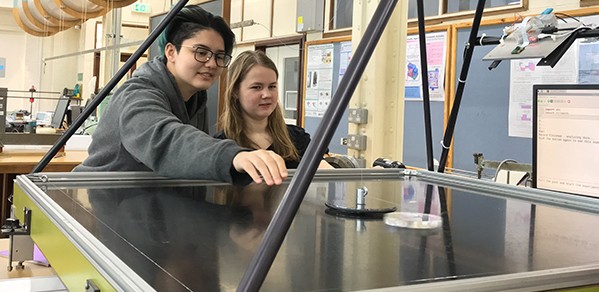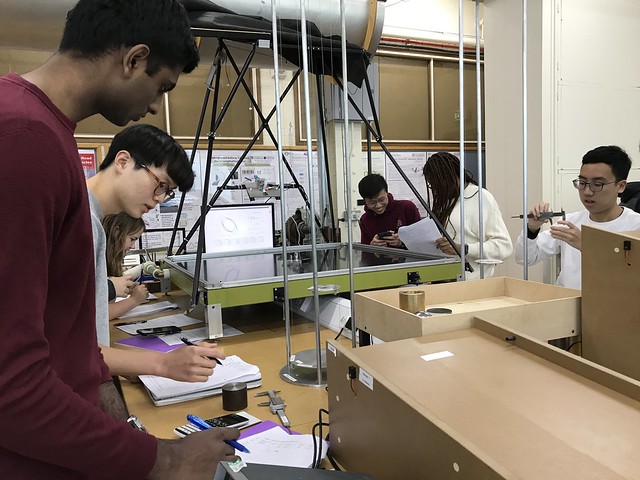
New practical experiments in mechanics have been introduced to first and second-year Engineering undergraduates – bringing to life theories of angular momentum, satellite motion, centre of mass, moment of inertia and motion of a double pendulum.
Working with different experimental apparatus and witnessing how scenarios in our problem sheets come to life in this lab session is really enjoyable and helpful for our learning.
Student Jiecong Tan
The new experiments – designed to support the content of the Part IA (first year) and Part IB (second year) Mechanics courses – have been refreshed and aim to demonstrate the mechanics theories mentioned in the students’ problem sheets.
These include:
Part IA
Observing orbital motion of a puck on an air table – conservation of angular momentum and calculating impact between discs of different sizes and rods of different masses *
Measuring moment of inertia of a selection of objects (steel, brass, aluminium, nylon) by timing oscillations of a trifilar pendulum (trifilar means “three strings”).
Determining the time of travel for objects (steel sphere, hollow brass cylinder) rolling down two different inclines equipped with motion sensors.
Part IB
Understanding the motion of a double pendulum – a non-linear system exhibiting chaos for large amplitudes and predictable periodic behaviour for small amplitudes *
* Both of these experiments make use of a Raspberry Pi (credit card-sized computer) fitted with an infrared camera to monitor motion.
By the end of Lent term 2023, approximately 340 undergraduates in each year will have completed the practical experiments.
Student Lonny McKiernan said: “The practical experiments help me understand the coursework I’m doing and help me connect with the teaching material. It’s something I can look at and interact with and I can gain a wider understanding of what I’m here for and the potential of Engineering undergraduate study at Cambridge.”
“Working with different experimental apparatus and witnessing how scenarios in our problem sheets come to life in this lab session is really enjoyable and helpful for our learning,” said fellow student Jiecong Tan. “It’s also fascinating to see how digital technologies, such as Raspberry Pi, can help with taking accurate real-life measurements of position and velocity.”
“I have enjoyed the practical demonstrations,” said student Samuel Hinks. “It’s hugely satisfactory seeing real data confirm your hypotheses, and interesting to try to diagnose the problems when it doesn’t.”
He added: “I think that, generally speaking, engineering students are quite practically minded, which is why a focus on practical applications and projects is one of the things that defines and attracts people to an engineering course. I also feel that working collaboratively in this way builds good co-operation between students, and that co-operation will in many cases then carry over into exam preparation and revision.”
Hugh Hunt, Professor of Engineering Dynamics and Vibration, said: “I’m really happy to see students enjoying themselves and they all say that the material that they’ve learned in lectures makes a lot more sense now that they have hands-on experience.”
About Engineering undergraduate study at Cambridge
The Cambridge Engineering course is unique. It allows you to keep your options open while equipping you with all the analytical, design and computing skills that underpin modern engineering practice.
Part I (Years 1 and 2) provides a broad education in engineering fundamentals, enabling you to make an informed choice about the area in which to specialise from your third year (many students change direction as a result).
In Year 1, you take four papers and sit a three-hour written exam in Mechanical Engineering; Structures and Materials; Electrical and Information Engineering and Mathematical Methods.
You also undertake several coursework activities and projects on topics including structural design, product design, presentation skills, drawing, laboratory experiments and computer programming.
In Year 2, you study seven papers, including Mechanics, on core subjects at a more advanced level. In addition, in the third term, you select two topics from seven engineering disciplines plus a language option. These topics emphasise engineering design and introduce the more specialised work of the third year.
Coursework includes laboratory experiments and computing exercises. Several experiments are linked around the common theme of earthquake-resistant structures. A highlight of the year is the integrated design project spanning multiple engineering disciplines, where you work in teams to design and build robot vehicles which are then tested against each other.
Find out more about the course, including information on Years 3 and 4.


